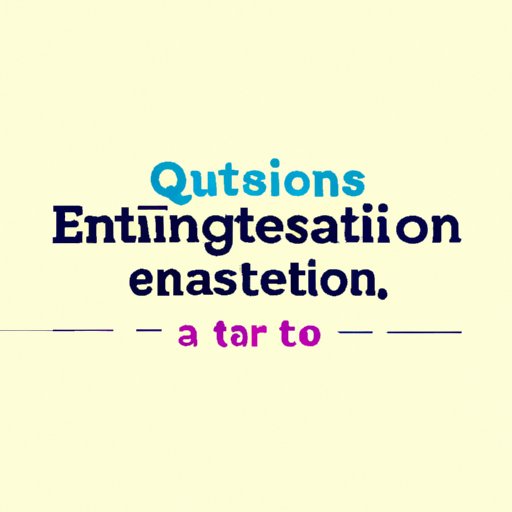I. Introduction
As writers, we often rely on quotes to support our ideas and arguments. However, introducing a quote is not always straightforward. Many writers struggle with how to introduce quotes effectively, often leading to awkward or clumsy writing. In this article, we will provide practical tips on how to introduce quotes in a way that enhances the flow and clarity of your writing.
II. Use a Signal Phrase to Introduce the Quote
A signal phrase is a phrase that alerts readers that a quote is incoming. It also sets the context and communicates the source, author, or speaker of the quote. Using a signal phrase is important because it helps readers understand where the quote comes from and its significance.
Some common signal phrases include “According to,” “In the words of,” “As stated by,” “According to the author,” or “As the speaker noted.” When choosing a signal phrase, consider the context and tone of the writing. For example, a formal academic paper may require more formal signal phrases, while a personal essay could use more conversational language.
III. Provide Context for the Quote
Providing context for the quote is essential for readers to understand its significance. The context sets the stage and helps readers frame the quote’s meaning. Avoid lengthy or irrelevant summaries that may dilute the quote’s impact. Instead, aim to summarize the author or speaker’s background and qualifications briefly.
For example, if you are quoting a famous scientist, provide a short background on their qualifications and research accomplishments. Additionally, if the quote is from a longer work, such as a book or speech, provide a brief overview of the work’s main ideas.
IV. Emphasize the Importance of the Quote
Explaining why the quote is relevant to the topic or main idea of the article is essential to readers’ understanding. To emphasize the importance of the quote, align it with the focus of the writing. For example, if the article is about climate change, use a quote that reinforces the article’s central argument.
Also, convey how the quote adds value to the reader’s understanding. For instance, you could explain how the quote highlights a specific aspect of the topic or provides a unique perspective on the issue.

V. Use Rhetorical Questions to Introduce the Quote
Rhetorical questions can be an effective way to introduce quotes because they capture the reader’s attention. The question serves as a hook and creates curiosity about the upcoming quote. However, it’s essential to craft the right question that aligns with the quote’s significance and the article’s tone.
For instance, if you are quoting a statistic on the prevalence of cyberbullying, you could use the question, “Did you know that 34% of teenagers experience cyberbullying?” This rhetorical question is engaging and prompts readers to read further into the article.
VI. Use Transitional Phrases to Segue into the Quote
Transitional phrases that link the previous sentence to the upcoming quote are effective in preparing the reader for the quote. They serve as a bridge and create a seamless connection between ideas. Some transitional phrases that can be used include “In addition,” “Moreover,” “Furthermore,” or “On the other hand.”
It’s important to use a variety of transitional phrases, as using the same phrase repetitively can become monotonous.
VII. Use a Contrary or Unexpected Statement to Introduce the Quote
Using a contrary or unexpected statement can be a powerful way to introduce a quote. It creates tension and intrigue, making readers curious about the quote’s relevance. However, it’s important to balance creativity with accuracy and ensure that the statement aligns with the article’s tone and objective.
For instance, if the article is discussing the benefits of exercise, you could use the contrary statement, “Many people believe that exercise is a waste of time. However, recent studies reveal that exercise can improve overall health and reduce the risk of chronic diseases.”
VIII. Use Personal Anecdotes or Stories to Introduce the Quote
Personal anecdotes or stories can be engaging for readers and add a touch of personality to your writing. They provide context and emotional impact, making the quote more memorable. However, it’s important to choose anecdotes or stories that relate directly to the quote’s significance.
For example, if you are quoting a politician’s speech on social justice, you could use a personal anecdote about your experiences with discrimination. This personal connection creates a powerful link between the writer, reader, and the quote.
IX. Conclusion
Introducing quotes effectively can elevate the quality of your writing and enhance the reader’s understanding. By using signal phrases, providing context, emphasizing the quote’s importance, using rhetorical questions, transitional phrases, contrary or unexpected statements, or personal anecdotes, writers can seamlessly integrate quotes into their writing.
Our final tip is to practice incorporating these tips into your writing. Experiment with different techniques and find what works best for you. With practice, you can confidently introduce quotes effectively and impactfully in your writing.
